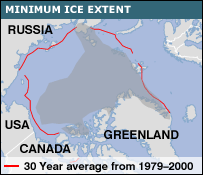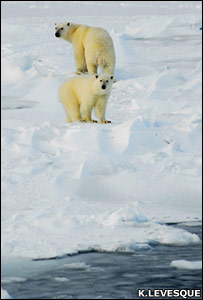2013년 여름에는 북극에 얼음이 없다.
조나단 에이머스
과학 기자, BBC, 샌프란시스코

2007년 여름, 북극 빙하 최고로 많이 녹아
미국 과학자들이 북극해의 빙하가 사라질 것이라는 극적인 예고를 했다.
그들의 최신 연구에 따르면, 북극해는 5~6년 이내에 얼음 없는 여름을 맞을 수 있다고 한다.
위슬로 마슬로우스키 Wieslaw Maslowski 교수는 미국 지질물리학연합 회의에서, 이전의 예측들은 현재의 얼음 감소 추이를 과소평가한 것이라고 말했다.
올여름(2007) 해빙으로 얼음은 현대에 들어 가장 작은 면적인 총 면적 413만 km로 줄었다.
이 놀랍도록 현저히 낮은 수치는 마슬로우스키 교수와 그의 팀이 1979년에서 2004년까지의 자료를 활용하여 만든 미래 예측 모델로도 예측되지 않았던 바이다.
캘리포니아 몬터레이 해군대학원의 한 연구원은 BBC에 이렇게 설명한다.
"우리의 2013년 여름 빙하 완전유실 예상 도에서는 최근 일어난 2005년, 2007년 기록된 2회의 최저치를 예측할 수 없었습니다." "따라서 주어진 사실로 볼 때, 우리의 2013년 빙하 완전유실 예상도는 벌써 꽤 온건론이 되어버린 것일 수도 있습니다."
"마지막엔 갑자기 아주 빨리 녹아 버릴 것이다." - 피터 와드햄 교수 Professor Peter Wadhams -
현실 세계
최근 기후 과학에서 가능한 미래의 결과 예측을 위해 슈퍼컴퓨터를 사용하는 것이 일반화되었다.
나사 NASA 협력 인들과 해양학회, 폴란드 과학연구원이 포함되어 있는 마슬로우스키 교수팀은 다른 연구팀들보다 선두에서 구체화된 자료를 만드는 것으로 유명하다.
다른 연구팀들은 여름 대양 완전해빙에 대해 2040년에서 2100년까지 다양한 시기를 말한다.
하지만, 몬터레이 연구원은 이러한 예측들은 몇몇 중대한 해빙 과정들을 심하게 과소평가하고 있다고 한다.
특히 마슬로우스키 교수는 그러한 예측들에 따뜻한 해수가 태평양과 대서양에서 북극해 유역으로 이동하는 실제적 작용을 포함해 계산해야 한다고 단호히 주장한다.
마슬로우스키 교수는 이렇게 말한다.
"세계 기후 모형들은 대양 기류 현상으로 빙하에 전달되는 열의 양을 과소평가하고 있습니다."
"그들의 부족한 공간 분석력 때문에 중요한 상세 요인들을 보지 못하는 것이 그 이유입니다."
"우리는 북극해와 위협받고 있는 빙하에 대한 실제적 대기(大氣) 자료를 이용한 정확도 높은 모델을 사용합니다. 그것으로 대기에서 대양 밑바닥까지 보다 실제적으로 작용하는 에너지를 얻어냅니다."
기후변화에 대한 국제 간 패널(IPCC)은 유엔 주재로 지구 기후 체계의 상태를 산정하는 곳이다. 북극 빙하 손실예측에 예측모델들의 평균을 사용한다.
그런데 근 몇 년 동안의 실제 여름 해빙 속도는 명백히 그 예측모델들보다 훨씬 더 빨라지기 시작했다.
2007년 9월에는 빙하 면적이 최저치에 달아 이전의 최저 빙하면적기록인 2005년 532만km를 갱신했다.
1979년부터 2000년까지의 자료의 장기간 평균 최소치는 674만 km이다.
비교하면, 2007년은 거의 알래스카와 텍사스를 합한 크기 또는 영국의 10에 달하는 크기인 261만km가 더 작은 것이다.
재차 감소 중
영국 케임브리지 대학 피터 와드햄 교수는 북극 빙하 전문가이다.
그는 영국 해군 잠수함이 수집한 수중 음파 탐지기 자료를 사용하여 손실된 부피가 손실된 면적을 능가했음을 보였다. 이는 마슬로우스키 교수의 예측모델 결과와 일치되는 것이었다.
와드햄 교수는 이렇게 말한다.
"몇몇 예측모델들은 현재 진행되고 있는 물리적 현상을 정확히 계산하지 않았습니다."
"얼음의 두께가 감소하는 면적보다 더 빠르게 얇아지고 있습니다. 몇몇 예측모델 제작자들을 빙하라기보다 두꺼운 판으로 보고 있습니다."
"위슬로의 예측모델이 보다 유효합니다. 자료를 바탕으로 한 얼음 내부의 변화를 고려하고 있기 때문입니다."
북서항로를 따라서
그는 해빙으로 개방된 해양이 더 많은 태양 복사열을 받아들여 온난화를 가속하고 더 빠른 해빙을 발생시키는 "빙하 알베도" (빙하로 인해 반사되는 태양광 비율) 순환 효과를 예로 들었다.
와드햄 교수는 북극권의 해빙은 앞으로 더욱 가속화 될 것이라 말한다.
"이 결과는 어떤 주기적 현상이나 단순한 등락현상이 아닙니다. 올해 해빙된 양은 다음해의 전제조건이 되어 같은 현상을 더 심하게 일으킬 것입니다."
"해양은 해빙으로 더욱 개방되고, 더 많은 열 흡수는 더 많은 해빙을 일으킵니다."
"마지막에는, 갑자기 아주 빨리 녹아버릴 것입니다. 그것이 2013년 만큼 이르지 않다 해도 아주 가까운 시일 내에 일어날 것입니다. 2040년보다는 훨씬 더 빠르게요."
미국 설빙자료센터(NSIDC)는 북극해 빙하면적 관찰자료를 수집하고 정기적으로 상태를 보고 한다. 그곳의 연구 과학자인 마크 세레즈Mark Serreze 박사는 금년 지구물리학회(AGU) 추계회의에서 본강연을 맡아줄 것을 요청받았다.
그는 해빙으로 인한 여름철 북극해 개방 가능성에 대한 토론에서 이렇게 말했다.
"몇 해 전에는 심지어 저도 2050년이나 2070년, 2100년 후의 일이라 생각했습니다.
우리가 만든 예측모델들의 결과가 그러했으니까요.
그런데 우리가 봐온 것처럼, 이제 그 예측 모델들의 속도는 실제 상황만큼 충분히 빠르지 않습니다.
훨씬 더 급속도로 해빙이 일어나고 있습니다."
"2030년이 터무니없는 시기라고 생각되지 않습니다"
그리고 후에 세레즈 박사는 비비씨 BBC에 덧붙여 말했다.
"위슬로의 예측이 약간 저돌적일 수도 있겠지요. 자연 변화로 빙하 손실이 이전 해보다 약간 덜해져서 운 좋게도 몇 년이 더 늦춰질 수도 있으니까요. 그렇지만, 위슬로는 빈틈없는 사람입니다. 그러니 그의 예측대로 된다 해도 저는 놀라지 않을 것입니다."
앨 고어 미국 전 부통령은 오슬로에서 갖은 노벨평화상 수상연설에서 마슬로우스키 교수의 분석을 인용했다.
2007.12.12
Jonathan.Amos-INTERNET@bbc.co.uk
source:bbc.co.uk
news.bbc.co.uk/1/hi/sci/tech/7139797.stm
Arctic summers ice-free 'by 2013'

